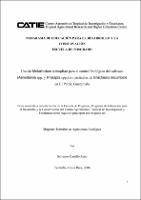| dc.contributor.advisor | Carballo Vargas, Manuel | |
| dc.contributor.author | Castillo Zeno, Salvador | |
| dc.date.accessioned | 2014-10-17T06:17:08Z | |
| dc.date.available | 2014-10-17T06:17:08Z | |
| dc.date.issued | 2006 | es_ES |
| dc.identifier | 368446 | es_ES |
| dc.identifier.uri | https://repositorio.catie.ac.cr/handle/11554/550 | |
| dc.description | Tesis (M. Sc) -- CATIE, Turrialba (Costa Rica),2006 | es_ES |
| dc.description.abstract | además se determinó la calidad de biomasa del pasto. Se identificaron dos especies Aeneolamia albofasciata y Prosapia simulans. Se determinó que el pH de la masa de espuma o salivazo es alcalino. La dinámica poblacional del salivazo en el área de estudio está estrechamente asociada al patrón de la precipitación pluvial. Se observó que en pastizales sin cobertura árborea la especie prodominante fue Aeneolamia albofasciata mientras que bajo cobertura árborea fue Prosapia simulans. Cerca del área experimental se encontró un hongo nativo que causó una epizootia en adultos de salivazo el cual se identificó como Batkoa sp. Se determinó que el contenido de proteína y digestibilidad de la pastura es afectado fuertemente y la pérdida de Producción de biomasa fue del 100 por ciento a causa del ataque del salivazo. En el presente estudio se evaluaron tres cepas de Metarhizium anisopliae y un control (agua) utilizando dos formas de aplicación: convencional (200 l agua/ha) y en bajo volúmen (60 l agua/ha) en fincas con pasto Brachiaria decumbens con una dosis de 2.5 x 10 exponente 12 conidios/ha. Se hicieron dos aplicaciones con un intervalo de 30 días. Se realizaron muestreos semanales de la población de ninfas utilizando un marco metálico de 0.5 x 0.5 m y de adultos con una red entomológica The objective of this study was to evaluate three commercial strains of Metarhizium anisopliae, with water as control by using two forMON of aplication: conventional (200 l water per ha) and in low volumen (60 l water per ha) in farMON with Brachiaria decumbens. the dose applied was 2.5 x 10 exponent 12 conidia per ha. Two applications were made with an interval of 30 days. the nymphs and adults populations were sampled on a weekly basis. The nymphs were sampled by using a 0.5 x 0.5 m matallic square and adults were sampled with an entomological net. The quality of grass biomass was also determined. In this study two species of spittlebugs were identified: Aeneolamia albofasciata and Prosapia simulans. The pH of the mass of foam or froth was alkaline. The population dynamics of the spittlebugs in the study area was closely associated to the rainfall pattern. It was observed that Aeneolamia albofasciata dominated in grasslands with no shade trees while Prosapia simulans dominated in grasslands with shade trees. A native entomophathogenic fungi was found near the study site which caused epizootic disease in adult spittlebugs. The fungi was identified as Batkoa spp. Protein content and grass digestibility was severely affected and biomass production decreased by 100 per cent with spittlebug attacks. | es_ES |
| dc.language.iso | es | es_ES |
| dc.publisher | Centro Agronómico Tropical de Investigación y Enseñanza (CATIE) | es_ES |
| dc.subject | GUATEMALA | |
| dc.subject | BRACHIARIA DECUMBENS | |
| dc.subject | POACEAE | |
| dc.subject | AENEOLAMIA | |
| dc.subject | METARHIZIUM ANISOPLIAE | |
| dc.subject | HONGOS ENTOMOPATOGENOS | |
| dc.subject | AGENTES DE CONTROL BIOLOGICO | |
| dc.subject | INSECTOS DAÑINOS | |
| dc.subject | CONTROL BIOLOGICO | |
| dc.subject | CONTROL DE PLAGAS | |
| dc.subject | DINAMICA DE POBLACIONES | |
| dc.title | Biological control of the spittlebugs (Aeneolamia spp. and Prosapia spp.) with use Metarhizium anisopliae in Brachiaria decumbens grasslands in El Petén, Guatemala | es_ES |
| dc.title.alternative | Uso de Metarhizium anisopliae para el control biológico del salivazo (Aeneolamia spp. y Prosapia spp.) en pastizales de Brachiaria decumbens en El Petén, Guatemala | es_ES |
| dc.type | Tesis de maestría | es_ES |
| dc.identifier.publication | Turrialba (Costa Rica) | es_ES |


